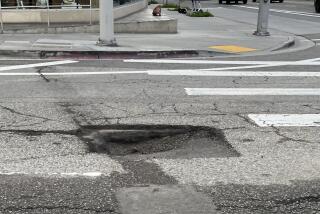Plan to Make L.A. More ‘Family Friendly’ Unveiled : Services: Mayor’s group recommends forming a city commission to help coordinate programs and stretch resources.
- Share via
Seeking a better-coordinated--and more generous--approach to Los Angeles’ myriad programs for children and families, a volunteer committee convened by Mayor Richard Riordan has recommended forming a city commission and establishing a trust fund to accept private donations.
In a report released Tuesday in the Children’s Reading Room at the Central Library, the Mayor’s Committee on Children, Youth and Families also called for neighborhood networks to plan and coordinate programs tailored to their own community’s needs.
Although the city is spending $215 million this fiscal year on more than 100 programs for youths or families, the committee found that the amount represents less than 5% of the city’s $4.8-billion budget and falls far short of meeting the needs. Four out of five of the city’s 860,000 people under 18 belong to households without a parent at home during the work day, and one in four lives in poverty.
Moreover, the committee reported that many of the services are fragmented and sometimes overlap, and few have been evaluated as to effectiveness. The nearly three dozen committee suggestions are aimed at stretching resources and righting inequities during a time of growing need and lean municipal revenues.
“We all know public dollars are shrinking and L.A. has to find a new way to work in order to meet the needs and challenges of children and families,” said Nancy Daly, a longtime children’s activist and close friend of the mayor.
Daly, a 10-year member of the Los Angeles County Commission for Children’s Services, chaired a group of 18 child-care providers, educators, child and family experts and business people appointed to find ways to make the city more “family friendly.”
The group is the latest example of what has become a hallmark of the Riordan Administration--appointing a citizens committee that donates its time to study a particular issue or problem and makes recommendations. Like the suggestions offered by other committees, many of the things proposed Tuesday would need City Council approval or depend on some new spending during an especially lean budget year.
One proposal likely to raise eyebrows in some quarters is the recommendation to form a commission that would cost $500,000 in its first year--this from a business-oriented Administration that has vowed to pare the city bureaucracy and cut expenses.
But Deputy Mayor Robin Kramer said the mayor’s office views the commission formation as an investment that would maximize services, make them more efficient and save money in the long run. More than half the cost of an eight-member commission staff would be met by transferring employees from the mayor’s office and the Personnel Department; the $46,000 proposed for equipment and office furniture is expected to be a one-time cost.
The proposed nine-member Commission on Children, Youth and Their Families also would oversee a trust fund to supplement tax money spent on child or family services. Contributions of $5,000 or more would require City Council approval before they could be accepted. The commission would have the authority to spend money from the fund as long as the expenditures met commission and city guidelines and did not run counter to the city budget policies, which are set by the mayor and council.
In its task of improving coordination and dissemination of services, the commission would face many challenges, the committee said. It noted, for example, that there is no formal mechanism for collaboration among departments or with outside agencies and found that few departments consider the effect their programs or policies have on children and families.
The committee also found large discrepancies among neighborhoods in the recreation and cultural resources readily available to families. In the San Fernando Valley, according to the city Recreation and Parks Department, there is one acre of park for every 350 acres of land. In the city’s urban core, however, the ratio is 1 to 3,500.
“The challenge will be to find alternate resources for children in neighborhoods that don’t have the parks, libraries and other things that are available in other communities,” Daly said. “We’re going to have to get very creative, but I think the opportunities are there. . . . With the help of the mayor and the council, I know we can do it.”
(BEGIN TEXT OF INFOBOX / INFOGRAPHIC)
Making the City Better for Children A yearlong review by a committee of volunteers convened by Los Angeles Mayor Richard Riordan came up with nearly three dozen suggestions for making the city better for children and their families. Here are some key recommendations:
* Coordination: Establish a commission to coordinate and evaluate programs and to act as advocates for issues that affect youngsters.
* Networks: Create neighborhood networks and interdepartmental teams to help tailor services to communities.
* Trust Fund: Organize a trust fund to accept private contributions for expanding or adding programs.
* Improvements: Find ways to ensure clean, safe and economically viable neighborhoods.
* Activities: Help ensure that every youngster under 18 “has something to do, someone to do it with and a safe place to do it,” including expanding on proven projects, such as the after-school program run by the school district and financed the city.
More to Read
Sign up for Essential California
The most important California stories and recommendations in your inbox every morning.
You may occasionally receive promotional content from the Los Angeles Times.














